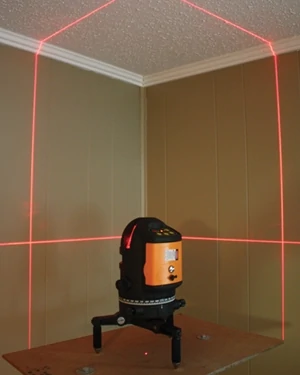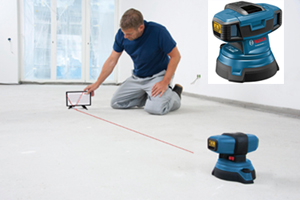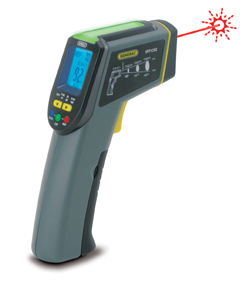Matt Weber
Modern technology is a mixed bag. Although I’m generally disappointed in the glaring absence of flying cars and hover-boards that I envision-ed as a kid, the U.S. did recently invade Mars, and our generation has lots of awesome laser gadgets at our disposal. Here’s a look at today’s laser tools for home improvement.
Laser Line Generators
Laser layout tools can generate perfectly plumb and level guidelines that save a great deal of time when compared to painstakingly measuring and marking each reference point with pencils, tapes, hand levels or string levels.
Contractor-grade tools like the Quad-Line Self-Leveling Cross Line Laser from Johnson Level & Tool can project a grid of red guidelines on walls or ceilings, just like some futuristic thingamajig that you’d expect to see on Star Trek. The Quad-Line provides easily visible reference lines that assist all sorts of projects, whether you’re installing trim, shelves, cabinets, wall tile, or masking a wall for paint—the possibilities are endless. The unit generates three vertical lines, two horizontal lines and one plumb-down beam. Plus, the laser is “self-leveling” insofar as an alarm blinks and beeps when it’s beyond leveling range, indicating that it needs adjustment at its tripod base. There’s also a manual mode as well as a locking mechanism that protects the laser’s inner components during transportation. The laser has an interior range up to 200 ft. (depending on light conditions). The Quad-Line package includes one Ni-MH rechargeable battery pack, 6.4-volt battery adapter, magnetic target, hard-shell carrying case and tinted glasses for better visibility of the laser lines in low-light conditions.

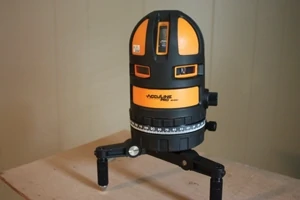
The Bosch GLL2-40 doesn’t offer as many bells and whistles as the contractor-grade Quad-Line, but it is an easy-to-use and accurate cross-line laser for interior jobsites up to 30 feet. It’s a self-leveling laser with single-button operation that makes it simple to select horizontal, vertical, cross-line or manual mode operation. This lightweight cross-line laser includes a detachable floor and magnetic mount that allows full rotation so you can position it right where you need it. The mount is also equipped with a convenient 1/4- or 5/8-in. tripod mounting thread for additional mounting options.
Surface Levels
The latest advancement in laser-tool technology is the new GSL 2 Surface Level from Bosch. This first-of-its-kind laser continuously checks floor levels and flatness.
It works by projecting two lasers very closely together across the floor. Rotate the unit on its base, casting the lasers across the floor all around the room. Wherever there is a bump or recess in the floor, the beams will separate into two distinct lines, enabling you to mark the problem areas for re-work. Furthermore, when you reach a problem area of the floor, you can align the lasers with the accessory target plate to determine the height deviation at the uneven spot. The GSL 2 requires just one person to operate and eliminates the need for multiple floor spot checks that can kill time and productivity.
Laser Measuring Devices
Among the EHT staff’s favorite tool innovations of the last decade is the advent of the laser measuring devices that are suited for the light-duty contractor and DIY’er. These tools are also called distance-meters, ranger finders or laser “tape” measures, depending on manufacturer (or construction crew). The tools work similarly to a conventional tape measure but utilize a laser beam instead of metal tape. Once you have the laser aimed, just press a button and the device calculates the distance and displays it on screen. The measurement is taken with precision laser optics that accurately measure the distance of the beam that hits a target object. If there’s no wall, post or other object at the end of your measurement, you’ll need to set up a target where the laser beam can reflect.
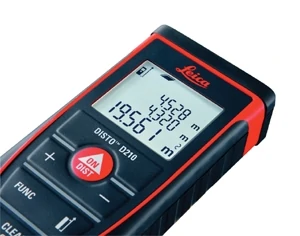
These measuring devices have a multitude of uses. They’re quicker than standard tapes. They can measure high ceilings and other hard-to-reach spaces without a second person or a ladder. Plus, they eliminate mistakes associated with a twisted or sagging metal tape.
Back in 1993, the Leica DISTO made its debut as the original laser measurer. Today, the entry-level versions of these laser tools can measure with an accuracy of ± 1.0 mm at the push of a button. Designed especially for indoor applications, some models have a range up to 230 ft. (even greater with the high-end contractor models). Standard features include shortcut keys for addition, subtraction, and calculation of area and volume. Look for a range finder with a multifunction end-piece; whether measuring from corners, slots or edges, the tool detects the end-piece automatically and figures it into the measurement. Available from Leica, Bosch, DeWalt and others, the tools are compact and lightweight enough to fit in your pocket, and the measurement results are clearly shown on a digital screen, some of which are even backlit for reading in the dark.
Laser-sited Thermometer/Scanner
For a home energy audit, consider using a laser-targeted thermometer. These handheld laser-sighted tools can detect surface temperatures to indicate energy loss around doors and windows, insulation, ductwork and other areas throughout the home. The new Infra Red Thermometer/Scanner (IRTC50) from General Tools & Instruments allows users to acquire a set-point temperature and determine whether subsequent readings are within or outside selectable ranges from that set point. As subsequent readings are taken, tri-color light and buzzer alarms indicate if those readings are within, above or below the selected range. With precision laser targeting, this gun-style, point-and-shoot instrument easily scans and measures surface temperatures without requiring direct contact to inaccessible or dangerous objects.
Laser Levels
Laser-equipped hand levels simply enhance the functionality of those must-have tools.
The 4-ft. e100 box level from Empire Level offers hi-tech features such as a digital readout and a laser centerline that projects from the end of the tool. The digital component reads slope, pitch and inch/foot in virtually any light, even when upside-down. It also holds its digital memory for later reference, and includes an audio button to hear a beep within one degree of level or plumb. The e100 is made of aircraft aluminum with shock-absorbing end caps, and the pinpoint laser has a range of 50 feet.

For a smaller laser level, the compact Checkpoint Ultra-Mag G3 Torpedo Level has a four-vial system, including 90-, 45-, 30- and 0-degree vials with oversized view ports that can be seen on all sides simultaneously. The level’s V-groove edge allows it to straddle almost any pipe up to 10 inches in diameter, and four large rare-earth magnets provide exceptional holding power to ferrous metals. You can enhance the G3 with the addition of the Ultra Mag Laser Base. It broadcasts a Class II pinpoint laser beam that is three-axis aligned to be accurate up to a 1/4-in. over 100 feet. Just like the G3 level, it features the
V-groove system and rare-earth magnets that let you set the Laser Base on almost any pipe. At only 8-1/2 inches, this laser/level combo easily fits inside most toolboxes.
Rotary Lasers
Rotary lasers offer 360-degree detection by spinning a projected laser around the jobsite in a dead-level pattern. For commercial-grade construction, rotary laser levels are considered indispensable for foundation leveling and grading work. For builders and remodelers, rotary lasers are ideal for framing a building, installing electrical outlets, adding a chair rail, or hanging a drop ceiling. The 360-degree elevation site line can guide your project whether you’re digging down or building up.
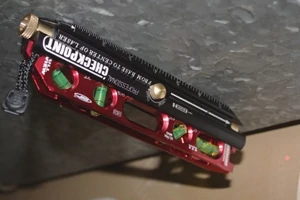
Green Laser Technology
Green lasers are now gaining ground in a market ruled by red. The color green is closer to the center of the visible light spectrum, so it’s easier for the human eye to perceive the color at night or in low-light conditions. Different colors of light, including laser beams, are determined by wavelength. A normal red laser has a wavelength of 650 nanometers versus a green laser that has even more energy in a wavelength of 532 nanometers. The smaller wavelength allows a higher frequency of waves to transmit within a given time. This gives humans the ability, when indoors, to see the green light better and more accurately than a red light. In fact, the beam of a green laser level is 400 percent brighter than a traditional red beam laser level.

So, why aren’t all lasers green? The color of a laser is determined by its diode, and red diodes are simpler and less expensive to manufacture. Green laser levels have been around for years for commercial industry, but only on very expensive laser tools ($3,000 and above). In 2005, Johnson Level developed a green laser level with a more affordable price. This technology may still be beyond the price range of many DIY’ers, but expect to see more advances in green laser technology in the future.
Other Related Tool Articles


